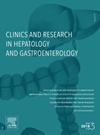Hepatic organoids as a platform for liver disease modeling and the development of novel therapies
IF 2.4
4区 医学
Q2 GASTROENTEROLOGY & HEPATOLOGY
Clinics and research in hepatology and gastroenterology
Pub Date : 2025-07-01
DOI:10.1016/j.clinre.2025.102647
引用次数: 0
Abstract
Background and aims
Liver diseases pose a major global health burden, and progress in understanding liver pathophysiology and therapeutic development is hampered by the lack of predictive human models. Hepatic organoids (i.e. 3D in vitro structures derived from primary, progenitor, or pluripotent stem cells) offer a physiologically relevant alternative to traditional 2D cultures and animal models. This review provides a comprehensive overview of hepatic organoid systems and their translational potential.
Methods
We reviewed recent advances in the generation, culture, and characterization of hepatic organoids. The discussion covers the diversity of cell sources, 3D matrix-based and microfluidic culture platforms, and analytical approaches used to assess organoid structure, function, and heterogeneity. Applications in disease modeling, drug development, and regenerative therapies were also examined.
Results
Hepatic organoids recapitulate key liver-specific functions, including albumin secretion, CYP450 activity, and bile canaliculi formation. They have been used to model monogenic and complex liver diseases (e.g., MAFLD, viral hepatitis, cancer) and to predict patient-specific drug responses. Integration into organ-on-chip systems enhances maturation and functional fidelity. Transplantation studies in bile duct ligation and hepatotoxic injury models demonstrated functional engraftment and regeneration. Limitations persist, notably in vascularization, immune integration, and standardization, but emerging solutions such as 3D bioprinting, defined matrices, co-culture strategies, and complementary approaches like bioartificial liver (BAL) systems, are advancing organoids toward clinical applicability.
Conclusion
Hepatic organoids are transformative platforms in hepatology, bridging experimental modeling and personalized medicine. Their continued development promises to redefine liver disease research, precision pharmacology, and regenerative therapies.
肝类器官作为肝脏疾病建模和新疗法发展的平台
背景和目的银屑病是全球主要的健康负担,由于缺乏可预测的人类模型,对肝脏病理生理的理解和治疗进展受到阻碍。肝类器官(即来源于原代、祖细胞或多能干细胞的体外3D结构)为传统的2D培养和动物模型提供了生理学上相关的替代方案。这篇综述提供了肝类器官系统及其转化潜力的全面概述。方法综述了近年来肝类器官的产生、培养和表征方面的研究进展。讨论涵盖了细胞来源的多样性,基于3D基质和微流体培养平台,以及用于评估类器官结构,功能和异质性的分析方法。在疾病建模、药物开发和再生治疗方面的应用也进行了研究。结果肝类器官概括了关键的肝脏特异性功能,包括白蛋白分泌、CYP450活性和胆管形成。它们已被用于模拟单基因和复杂的肝脏疾病(例如,mald、病毒性肝炎、癌症),并预测患者特异性药物反应。集成到器官芯片系统增强成熟和功能保真度。在胆管结扎和肝毒性损伤模型中的移植研究证实了功能植入和再生。局限性仍然存在,特别是在血管化、免疫整合和标准化方面,但新兴的解决方案,如3D生物打印、定义基质、共培养策略和生物人工肝(BAL)系统等补充方法,正在推动类器官走向临床应用。结论肝类器官是肝病学的变革平台,是连接实验建模和个体化医学的桥梁。它们的持续发展有望重新定义肝病研究、精准药理学和再生疗法。
本文章由计算机程序翻译,如有差异,请以英文原文为准。
求助全文
约1分钟内获得全文
求助全文
来源期刊

Clinics and research in hepatology and gastroenterology
GASTROENTEROLOGY & HEPATOLOGY-
CiteScore
4.30
自引率
3.70%
发文量
198
审稿时长
42 days
期刊介绍:
Clinics and Research in Hepatology and Gastroenterology publishes high-quality original research papers in the field of hepatology and gastroenterology. The editors put the accent on rapid communication of new research and clinical developments and so called "hot topic" issues. Following a clear Editorial line, besides original articles and case reports, each issue features editorials, commentaries and reviews. The journal encourages research and discussion between all those involved in the specialty on an international level. All articles are peer reviewed by international experts, the articles in press are online and indexed in the international databases (Current Contents, Pubmed, Scopus, Science Direct).
Clinics and Research in Hepatology and Gastroenterology is a subscription journal (with optional open access), which allows you to publish your research without any cost to you (unless you proactively chose the open access option). Your article will be available to all researchers around the globe whose institution has a subscription to the journal.
 求助内容:
求助内容: 应助结果提醒方式:
应助结果提醒方式:


